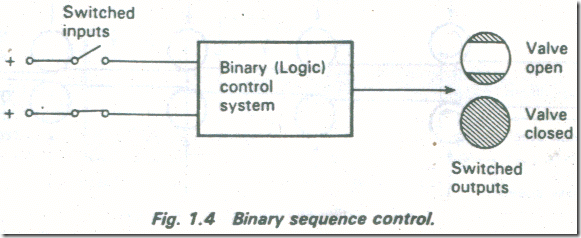DIGITAL (BINARY) AND ANALOG SYSTEMS
In the real world, most naturally varying quantities such as temperature, speed, position etc., change gradually and continuously across an infinite range of values; they are analog quantities. Fig. 1.2(a) shows an analog waveform with varying amplitude and frequency. Many sensors generate analog signals that vary either in frequency or amplitude depending on the sensor and measured quantity. Typical signals have amplitude variation of 0-5 V; for sensors with varying frequency output, the range depends on 60th process and signal conditioning.
Many devices produce or respond to digital signals, however, where there are only two possible levels (see Fig. l-2(b). The two states may represent:
|
on |
or |
off |
|
open |
or |
closed |
|
yes |
or |
no |
|
+ 5 V |
or |
0V |
|
1 |
or |
0 |
|
true |
or |
false |
These two-stale signals can be represented using the binary (base 2) numbering system, where one level is assigned the value of 1 and the other the value 0. Thus, in digital (binary) systems, the actual signal level (e,g. voltage) is important only in terms of representing a logic 1 or 0, rather than for its exact (analog) quantity.
Analog (continuous control)
Continuous or analog control uses directly representative input signals from sensors, and drives associated output devices (actuators) such as valves, pumps, healers, etc. These actuators may also be continuously variable, or simply be on/off switched units (Fig. 1.3).
The signal processing that takes place within the control system depends on the individual process involved, but typically involves signal amplification and some about the desired change in an output device.
Continuous controllers include analog electronic systems, computers and microcomputers.
Discontinuous (binary) control
Discontinuous or onoff control is commonplace in most industries, since many machines and processes consist of units (that can be in only one of two conditions) controlled by a larger number of simple operations or sequence steps. There are many instances where the input signal is commonly discrete in form, e.g., pulses from a switch, ‘bits’ of data from a keyboard, etc. In such cases we employ binary switching techniques. This should not be regarded as an inferior form of control compared the continuous method – each has its own area of application and is most efficient in that area. The levels of control plan sophistication found in binary systems can often match or surpass that found in continuous control systems.
Binary sequence controllers (Fig. 1.4) include relays, electronic/pneumatic/ hydraulic logic systems, computers and microcomputers, programmable controllers.
Both analog and digital control methods are dealt with in the remainder of this chapter.



